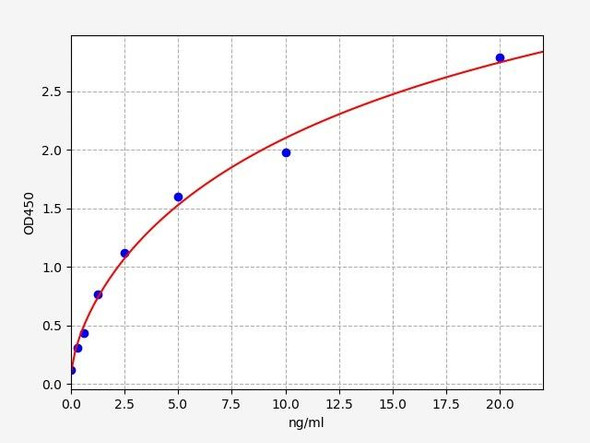Human Chymase (CMA1) ELISA Kit
- SKU:
- HUEB2139
- Product Type:
- ELISA Kit
- Size:
- 96 Assays
- Uniprot:
- P23946
- Range:
- 0.312-20 ng/mL
- ELISA Type:
- Sandwich
- Synonyms:
- CMA1, Chymase, Alpha-chymase, Mast cell protease I
- Reactivity:
- Human
Description
Human Chymase (CMA1) ELISA Kit
Key Features
| Save Time | Pre-coated 96 well plate | |
| Quick Start | Kit includes all necessary reagents | |
| Publication Ready | Reproducible and reliable results |
Overview
|
Product Name: |
Human Chymase (CMA1) ELISA Kit |
|
Product Code: |
HUEB2139 |
|
Size: |
96 Assays |
|
Alias: |
Chymase, Alpha-chymase, Mast cell protease I, CMA1, CYH, CYM, 3.4.21.39 |
|
Detection Method: |
Sandwich |
|
Reactivity: |
Human |
|
Range: |
0.312-20 ng/mL |
|
Storage: |
Please see kit components below for exact storage details |
|
Note: |
For Research Use Only |
Protein Information
|
Uniprot: |
P23946 |
|
UniProt Protein Function: |
CMA1: Major secreted protease of mast cells with suspected roles in vasoactive peptide generation, extracellular matrix degradation, and regulation of gland secretion. Belongs to the peptidase S1 family. Granzyme subfamily. |
|
UniProt Code: |
|
|
NCBI GenInfo Identifier: |
|
|
NCBI Gene ID: |
|
|
NCBI Accession: |
|
|
UniProt Related Accession: |
Kit Components
| Component | Quantity | Storage |
|
ELISA Microplate (Dismountable) |
8x12 strips |
4°C for 6 months |
|
Lyophilized Standard |
2 |
4°C/ -20°C |
|
Sample/Standard Dlution Buffer |
20ml |
4°C |
|
Biotin-labeled Antibody (Concentrated) |
120ul |
4°C (Protection from light) |
|
Antibody Dilution Buffer |
10ml |
4°C |
|
HRP-Streptavidin Conjugate (SABC) |
120ul |
4°C (Protect from light) |
|
SABC Dilution Buffer |
10ml |
4°C |
|
TMB Substrate |
10ml |
4°C (Protection from light) |
|
Stop Solution |
10ml |
4°C |
|
Wash Buffer (25X) |
30ml |
4°C |
|
Plate Sealer |
5 |
- |
Other materials required:
- Microplate reader with 450 nm wavelength filter
- Multichannel Pipette, Pipette, microcentrifuge tubes and disposable pipette tips
- Incubator
- Deionized or distilled water
- Absorbent paper
- Buffer resevoir
Protocol
*Note: The below protocol is a sample protocol. Protocols are specific to each batch/lot. For the correct instructions please follow the protocol included in your kit.
Allow all reagents to reach room temperature (Please do not dissolve the reagents at 37°C directly). All the reagents should be mixed thoroughly by gently swirling before pipetting. Avoid foaming. Keep appropriate numbers of strips for 1 experiment and remove extra strips from microtiter plate. Removed strips should be resealed and stored at -20°C until the kits expiry date. Prepare all reagents, working standards and samples as directed in the previous sections. Please predict the concentration before assaying. If values for these are not within the range of the standard curve, users must determine the optimal sample dilutions for their experiments. We recommend running all samples in duplicate.
| Step | Procedure |
|
1. |
Add Sample: Add 100µL of Standard, Blank, or Sample per well. The blank well is added with Sample diluent. Solutions are added to the bottom of micro ELISA plate well, avoid inside wall touching and foaming as possible. Mix it gently. Cover the plate with sealer we provided. Incubate for 120 minutes at 37°C. |
|
2. |
Remove the liquid from each well, don't wash. Add 100µL of Detection Reagent A working solution to each well. Cover with the Plate sealer. Gently tap the plate to ensure thorough mixing. Incubate for 1 hour at 37°C. Note: if Detection Reagent A appears cloudy warm to room temperature until solution is uniform. |
|
3. |
Aspirate each well and wash, repeating the process three times. Wash by filling each well with Wash Buffer (approximately 400µL) (a squirt bottle, multi-channel pipette,manifold dispenser or automated washer are needed). Complete removal of liquid at each step is essential. After the last wash, completely remove remaining Wash Buffer by aspirating or decanting. Invert the plate and pat it against thick clean absorbent paper. |
|
4. |
Add 100µL of Detection Reagent B working solution to each well. Cover with the Plate sealer. Incubate for 60 minutes at 37°C. |
|
5. |
Repeat the wash process for five times as conducted in step 3. |
|
6. |
Add 90µL of Substrate Solution to each well. Cover with a new Plate sealer and incubate for 10-20 minutes at 37°C. Protect the plate from light. The reaction time can be shortened or extended according to the actual color change, but this should not exceed more than 30 minutes. When apparent gradient appears in standard wells, user should terminatethe reaction. |
|
7. |
Add 50µL of Stop Solution to each well. If color change does not appear uniform, gently tap the plate to ensure thorough mixing. |
|
8. |
Determine the optical density (OD value) of each well at once, using a micro-plate reader set to 450 nm. User should open the micro-plate reader in advance, preheat the instrument, and set the testing parameters. |
|
9. |
After experiment, store all reagents according to the specified storage temperature respectively until their expiry. |
Sample Type
When carrying out an ELISA assay it is important to prepare your samples in order to achieve the best possible results. Below we have a list of procedures for the preparation of samples for different sample types.
| Sample Type | Protocol |
|
Serum |
If using serum separator tubes, allow samples to clot for 30 minutes at room temperature. Centrifuge for 10 minutes at 1,000x g. Collect the serum fraction and assay promptly or aliquot and store the samples at -80°C. Avoid multiple freeze-thaw cycles. If serum separator tubes are not being used, allow samples to clot overnight at 2-8°C. Centrifuge for 10 minutes at 1,000x g. Remove serum and assay promptly or aliquot and store the samples at -80°C. Avoid multiple freeze-thaw cycles. |
|
Plasma |
Collect plasma using EDTA or heparin as an anticoagulant. Centrifuge samples at 4°C for 15 mins at 1000 × g within 30 mins of collection. Collect the plasma fraction and assay promptly or aliquot and store the samples at -80°C. Avoid multiple freeze-thaw cycles. Note: Over haemolysed samples are not suitable for use with this kit. |
|
Urine & Cerebrospinal Fluid |
Collect the urine (mid-stream) in a sterile container, centrifuge for 20 mins at 2000-3000 rpm. Remove supernatant and assay immediately. If any precipitation is detected, repeat the centrifugation step. A similar protocol can be used for cerebrospinal fluid. |
|
Cell culture supernatant |
Collect the cell culture media by pipette, followed by centrifugation at 4°C for 20 mins at 1500 rpm. Collect the clear supernatant and assay immediately. |
|
Cell lysates |
Solubilize cells in lysis buffer and allow to sit on ice for 30 minutes. Centrifuge tubes at 14,000 x g for 5 minutes to remove insoluble material. Aliquot the supernatant into a new tube and discard the remaining whole cell extract. Quantify total protein concentration using a total protein assay. Assay immediately or aliquot and store at ≤ -20 °C. |
|
Tissue homogenates |
The preparation of tissue homogenates will vary depending upon tissue type. Rinse tissue with 1X PBS to remove excess blood & homogenize in 20ml of 1X PBS (including protease inhibitors) and store overnight at ≤ -20°C. Two freeze-thaw cycles are required to break the cell membranes. To further disrupt the cell membranes you can sonicate the samples. Centrifuge homogenates for 5 mins at 5000xg. Remove the supernatant and assay immediately or aliquot and store at -20°C or -80°C. |
|
Tissue lysates |
Rinse tissue with PBS, cut into 1-2 mm pieces, and homogenize with a tissue homogenizer in PBS. Add an equal volume of RIPA buffer containing protease inhibitors and lyse tissues at room temperature for 30 minutes with gentle agitation. Centrifuge to remove debris. Quantify total protein concentration using a total protein assay. Assay immediately or aliquot and store at ≤ -20 °C |
|
Breast Milk |
Collect milk samples and centrifuge at 10,000 x g for 60 min at 4°C. Aliquot the supernatant and assay. For long term use, store samples at -80°C. Minimize freeze/thaw cycles. |
CMA1 Background
Chymase, also known as Chymase 1 (CMA1), is a significant enzyme belonging to the serine protease family, primarily found in mast cells. These mast cells are an essential component of the body's immune system, playing a key role in immune responses, inflammation, and allergic reactions.
CMA1 Tissue Distribution and Mast Cell Localization
Chymase is predominantly found in mast cells, which are widely distributed throughout the body. These cells are particularly abundant in connective tissues, such as the skin, airways, and gastrointestinal tract, where they act as sentinels against invading pathogens and contribute to tissue repair. The unique presence of chymase in mast cells and its targeted release upon activation suggest a specialized role in the immune response, where it can influence the local microenvironment and modulate various immune and inflammatory processes.
CMA1 Proteolytic Activity and Substrates
One of the primary functions of chymase is its potent proteolytic activity. As a protease, it cleaves proteins at specific amino acid sequences, leading to the breakdown of extracellular matrix components, such as collagen and elastin. This proteolytic activity is crucial in tissue remodeling, wound healing, and the turnover of extracellular matrix proteins. However, improper regulation of chymase activity can lead to pathological tissue destruction and contribute to disease progression.
CMA1 in Inflammation and Immune Responses
Upon mast cell activation, chymase is released into the surrounding tissues, where it participates in the production and activation of various inflammatory mediators, such as cytokines and chemokines. These signaling molecules play essential roles in recruiting and activating immune cells, amplifying the immune response against invading pathogens. However, dysregulated chymase activity can lead to chronic inflammation and tissue damage, contributing to the development and progression of inflammatory diseases.
CMA1 Role in Allergic Reactions
Chymase is also involved in allergic reactions. When mast cells encounter allergens, they release various inflammatory mediators, including histamine, through chymase activation. Histamine is responsible for the characteristic symptoms of allergies, such as itching, swelling, and redness.
CMA1 FAQs
What is the CMA1 ELISA Kit?
The Human CMA1 ELISA Kit is an assay designed to quantify Human Chymase levels in biological samples.
What are the advantages of using the CMA1 ELISA Kit?
The CMA1 ELISA Kit offers high sensitivity, specificity for Human Chymase, easy-to-use protocol, quantitative results, compatibility with various samples, and time-efficiency for research screening.
Where can I find more information about the CMA1 ELISA Kit?
For more detailed information about the CMA1 ELISA Kit, including technical specifications, performance characteristics, and ordering details, please refer to the product brochure or contact our customer support team. We are here to assist you with any inquiries you may have.






